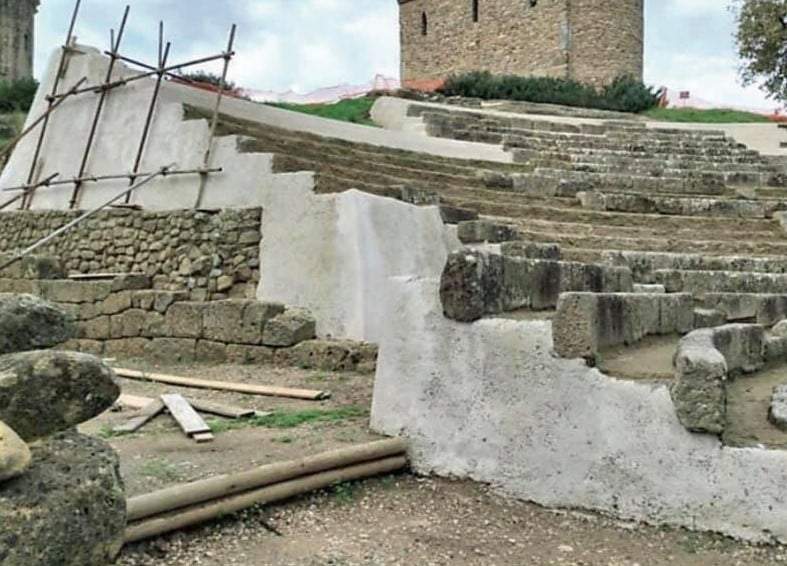Work on Velia’s ancient theater is at the center of a major controversy: the Campania-based archaeological site is part of the Paestum Archaeological Park and is currently the subject of a maintenance project involving the ancient theater itself. The controversy was sparked by architect Raffaele D’Andria, who lashed out against the intervention he said was “serious” and “unacceptable” in statements reported by the daily newspaper La Città di Salerno.
Stirring up tempers, the article says, is “the questionable visual impact produced by the restoration work at the theater overlooked by the medieval tower and built between the fourth and third centuries before Christ in the Hellenistic period above the previous assembly building.” The result, the piece goes on to say, is “a collage of white mortar that only time and moss will be able to antiquate.” D’Andria also stigmatizes the title of the project (“Interventions for the recovery and integration of the acropolis theater seating”), as in his opinion the intervention, The City continues, “seems to allude to a functional use of the same, a risky decision for the technician, according to which the future presence of the public could cause dangerous subsidence, since the reinforced earth base would not withstand loads in addition to those of the blocks.” In addition, D’Andria also pointed out, the newspaper reconstructs, “the excessive economic investment for a useless and low-quality product in terms of restoration, not hiding a lapidary ignorance with respect to the priceless heritage treated.”
Following Raffaele D’Andria’s complaint, Senator Margherita Corrado of the 5-Star Movement also moved, writing a letter to the secretary general of MiBACT, the General Directorate of Museums and the General Directorate of Archaeology, Fine Arts and Landscape, calling for an inspection. “Local media and social channels,” the missive reads, "made the country aware, a few days ago, of the technical choices and methods of execution of the intervention underway since last fall in the Hellenistic theater of Elea-Velia, within the Archaeological Park of the same name (now part of the ’Archaeological Park of Paestum and Velia’) highlighting, among other things, if reports are to be believed, that the design is owed to a surveyor and the role of RUP is played by an accountant. Since (bitter) laughter is wasted, as has unfortunately become habitual in the face of many initiatives taken by the executive offices of general level endowed with special autonomy with which this Administration manages the main Italian cultural places, I am to ask, making myself the spokesperson for the solicitations of the local community, that you would like to exercise, each to the extent of its competence, the duties of direction, guidance, coordination and control that the regulations attribute to you and would like to promptly order a careful inspection, aimed at ascertaining how it was possible, and why, to arrive at the deplorable results that the published images mercilessly document. Without neglecting, of course, the profiles of interest of the accounting judiciary."
Clarifications from the Archaeological Park of Paestum and Velia arrived in the afternoon. “An extraordinary maintenance intervention is currently underway in full compliance with the regulations and the fundamental principles of restoration, that is, recognizability and reversibility,” reads a note. “The intervention consists of restoring the seat integrations that were in an advanced state of deterioration at the time of the start of the construction site, with a special pozzolanic mortar developed for this purpose. The materials and techniques adopted do not involve direct contact between mortar and ancient parts, nor the use of cement. The color of the integrated parts will not be the one currently visible, but a darker shade that will still allow the conservative intervention to be clearly distinguished from the original structures.”
“The project, directed by arch. Luigi Di Muccio, with the collaboration of the technical and administrative staff of the Park,” the note continues, “has a dual purpose: it not only contributes to greater protection and conservation of the monument, but will also expand its accessibility. The previous restoration, dating back to the 2000s, in fact, explicitly included the impossibility of access to the cavea, and thus of allowing the public a close-up view of the monument. The current project will make part of the cavea safely accessible, both during the day and at night as it is equipped with a new lighting system, drawing inspiration from a vision of active protection that does not conflict with the knowledge and appreciation of the heritage, but attempts to bring the public closer to the monuments while ensuring their maximum preservation. In order to satisfy the public’s curiosity, as is the practice in the Park’s construction sites, the Velia theater site will also be open to visitors: every Friday at 3 p.m., provided with an entrance ticket, it will be possible to visit the construction site with the accompaniment of a construction worker. The first visit scheduled for February 12, will be by the director of the Archaeological Park of Paestum and Velia, Gabriel Zuchtriegel, who will explain the project to all interested parties.”
Pictured, work on the theater at Velia
 |
| Paestum, big controversy over work at Velia theater. Management clarifies |
Warning: the translation into English of the original Italian article was created using automatic tools. We undertake to review all articles, but we do not guarantee the total absence of inaccuracies in the translation due to the program. You can find the original by clicking on the ITA button. If you find any mistake,please contact us.